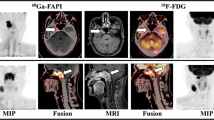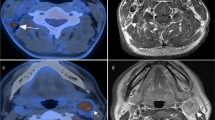Abstract
Purpose
This study aimed to explore the clinical utility of [68Ga]Ga-labeled fibroblast activation protein inhibitor ([68Ga]Ga-FAPI) positron emission tomography/computed tomography (PET/CT) relative to [18F]-fluorodeoxyglucose ([18F]FDG) PET/CT and magnetic resonance imaging (MRI) for primary staging and recurrence detection in nasopharyngeal carcinoma (NPC).
Methods
This retrospective analysis utilized a sub-cohort of patients from a previously acquired database. Patients with NPC who underwent [18F]FDG and [68Ga]Ga-FAPI PET/CT between October 2019 and November 2020 were included. The radiotracer uptake and clinical staging/restaging performances of [18F]FDG and [68Ga]Ga-FAPI PET/CT were compared.
Results
Forty-five participants (39 for initial assessment, 6 for recurrence detection) were included. In treatment-naïve participants, [68Ga]Ga-FAPI PET/CT showed higher radiotracer uptake than [18F]FDG PET/CT in primary tumors (16.18 vs. 10.11, P < 0.001), regional lymph nodes (11.42 vs. 7.37, P < 0.001), and bone and visceral metastases (6.94 vs. 3.11, P < 0.001). Compared with the [18F]FDG-based TNM stage, the [68Ga]Ga-FAPI-based TNM stage was upgraded in ten patients (26%), resulting in management changes in seven patients (18%). Compared with MRI, [68Ga]Ga-FAPI PET/CT upgraded and underestimated the T stage in four and two patients, respectively. In post-treatment patients, [68Ga]Ga-FAPI PET/CT yielded more true-positive findings than [18F]FDG PET/CT in detecting local recurrence.
Conclusion
[68Ga]Ga-FAPI PET/CT is a promising imaging modality for the diagnosis of primary and metastatic NPC. The exact tumor geographic imaging obtained through [68Ga]Ga-FAPI PET/CT may be a supplement to MRI for T staging and radiotherapy planning.




Similar content being viewed by others
References
Chua MLK, Wee JTS, Hui EP, Chan ATC. Nasopharyngeal carcinoma. Lancet. 2016;387(10022):1012–24. https://doi.org/10.1016/S0140-6736(15)00055-0.
Sham JS, Choy D, Choi PH. Nasopharyngeal carcinoma: the significance of neck node involvement in relation to the pattern of distant failure. Br J Radiol. 1990;63(746):108–13. https://doi.org/10.1259/0007-1285-63-746-108.
Chiesa F, De Paoli F. Distant metastases from nasopharyngeal cancer. ORL J Otorhinolaryngol Relat Spec. 2001;63(4):214–6. https://doi.org/10.1159/000055743.
Chen QY, Wen YF, Guo L, Liu H, Huang PY, Mo HY, et al. Concurrent chemoradiotherapy vs radiotherapy alone in stage II nasopharyngeal carcinoma: phase III randomized trial. J Natl Cancer Inst. 2011;103(23):1761–70. https://doi.org/10.1093/jnci/djr432.
Lee AW, Ma BB, Ng WT, Chan AT. Management of nasopharyngeal carcinoma: current practice and future perspective. J Clin Oncol. 2015;33(29):3356–64. https://doi.org/10.1200/JCO.2015.60.9347.
Yen RF, Chen TH, Ting LL, Tzen KY, Pan MH, Hong RL. Early restaging whole-body (18)F-FDG PET during induction chemotherapy predicts clinical outcome in patients with locoregionally advanced nasopharyngeal carcinoma. Eur J Nucl Med Mol Imaging. 2005;32(10):1152–9. https://doi.org/10.1007/s00259-005-1837-5.
Ng SH, Chan SC, Yen TC, Chang JT, Liao CT, Ko SF, et al. Staging of untreated nasopharyngeal carcinoma with PET/CT: comparison with conventional imaging work-up. Eur J Nucl Med Mol Imaging. 2009;36(1):12–22. https://doi.org/10.1007/s00259-008-0918-7.
Goldberg SB, Gettinger SN, Mahajan A, Chiang AC, Herbst RS, Sznol M, et al. Pembrolizumab for patients with melanoma or non-small-cell lung cancer and untreated brain metastases: early analysis of a non-randomised, open-label, phase 2 trial. Lancet Oncol. 2016;17(7):976–83. https://doi.org/10.1016/S1470-2045(16)30053-5.
Zhao L, Zhuang Y, Fu K, Chen P, Wang Y, Zhuo J, et al. Usefulness of [(18)F]fluorodeoxyglucose PET/CT for evaluating the PD-L1 status in nasopharyngeal carcinoma. Eur J Nucl Med Mol Imaging. 2020. https://doi.org/10.1007/s00259-019-04654-4.
Mu W, Jiang L, Zhang J, Shi Y, Gray JE, Tunali I, et al. Non-invasive decision support for NSCLC treatment using PET/CT radiomics. Nat Commun. 2020;11(1):5228. https://doi.org/10.1038/s41467-020-19116-x.
Zhang Y, Chen Y, Huang Z, Zhang L, Wan Q, Lei L. Comparison of (18)F-NaF PET/CT and (18)F-FDG PET/CT for detection of Skull-Base invasion and osseous metastases in nasopharyngeal carcinoma. Contrast Media Mol Imaging. 2018;2018:8271313. https://doi.org/10.1155/2018/8271313.
Lim JS, Kim MJ, Yun MJ, Oh YT, Kim JH, Hwang HS, et al. Comparison of CT and 18F-FDG pet for detecting peritoneal metastasis on the preoperative evaluation for gastric carcinoma. Korean J Radiol. 2006;7(4):249–56. https://doi.org/10.3348/kjr.2006.7.4.249.
Sivesgaard K, Larsen LP, Sorensen M, Kramer S, Schlander S, Amanavicius N, et al. Diagnostic accuracy of CE-CT, MRI and FDG PET/CT for detecting colorectal cancer liver metastases in patients considered eligible for hepatic resection and/or local ablation. Eur Radiol. 2018;28(11):4735–47. https://doi.org/10.1007/s00330-018-5469-0.
King AD, Ma BB, Yau YY, Zee B, Leung SF, Wong JK, et al. The impact of 18F-FDG PET/CT on assessment of nasopharyngeal carcinoma at diagnosis. Br J Radiol. 2008;81(964):291–8. https://doi.org/10.1259/bjr/73751469.
Xiang ZQ, Imani S, Hu Y, Ding RL, Pang HW, Chen Y, et al. Comparison of different images in gross target volume delineating on VX2 nasopharyngeal transplantation tumor models. J Cancer. 2020;11(5):1104–14. https://doi.org/10.7150/jca.36076.
Hamson EJ, Keane FM, Tholen S, Schilling O, Gorrell MD. Understanding fibroblast activation protein (FAP): substrates, activities, expression and targeting for cancer therapy. Proteomics Clin Appl. 2014;8(5–6):454–63. https://doi.org/10.1002/prca.201300095.
Kratochwil C, Flechsig P, Lindner T, Abderrahim L, Altmann A, Mier W, et al. (68)Ga-FAPI PET/CT: tracer uptake in 28 different kinds of cancer. J Nucl Med. 2019;60(6):801–5. https://doi.org/10.2967/jnumed.119.227967.
Altmann A, Haberkorn UA, Siveke J. The latest developments in imaging fibroblast activation protein (FAP). J Nucl Med. 2020. https://doi.org/10.2967/jnumed.120.244806.
Loktev A, Lindner T, Burger EM, Altmann A, Giesel F, Kratochwil C, et al. Development of fibroblast activation protein-targeted radiotracers with improved tumor retention. J Nucl Med. 2019;60(10):1421–9. https://doi.org/10.2967/jnumed.118.224469.
Chen H, Pang Y, Wu J, Zhao L, Hao B, Wu J, et al. Comparison of [(68)Ga]Ga-DOTA-FAPI-04 and [(18)F] FDG PET/CT for the diagnosis of primary and metastatic lesions in patients with various types of cancer. Eur J Nucl Med Mol Imaging. 2020;47(8):1820–32. https://doi.org/10.1007/s00259-020-04769-z.
Chen H, Zhao L, Ruan D, Pang Y, Hao B, Dai Y, et al. Usefulness of [(68)Ga]Ga-DOTA-FAPI-04 PET/CT in patients presenting with inconclusive [(18)F]FDG PET/CT findings. Eur J Nucl Med Mol Imaging. 2020. https://doi.org/10.1007/s00259-020-04940-6.
Ma H, Liang S, Cui C, Zhang Y, Xie F, Zhou J, et al. Prognostic significance of quantitative metastatic lymph node burden on magnetic resonance imaging in nasopharyngeal carcinoma: a retrospective study of 1224 patients from two centers. Radiother Oncol. 2020;151:40–6. https://doi.org/10.1016/j.radonc.2020.07.023.
Schmidkonz C, Rauber S, Atzinger A, Agarwal R, Gotz TI, Soare A, et al. Disentangling inflammatory from fibrotic disease activity by fibroblast activation protein imaging. Ann Rheum Dis. 2020;79(11):1485–91. https://doi.org/10.1136/annrheumdis-2020-217408.
Eisenhauer EA, Therasse P, Bogaerts J, Schwartz LH, Sargent D, Ford R, et al. New response evaluation criteria in solid tumours: revised RECIST guideline (version 1.1). Eur J Cancer. 2009;45(2):228–47. https://doi.org/10.1016/j.ejca.2008.10.026.
Serfling S, Zhi Y, Schirbel A, Lindner T, Meyer T, Gerhard-Hartmann E, et al. Improved cancer detection in Waldeyer’s tonsillar ring by (68)Ga-FAPI PET/CT imaging. Eur J Nucl Med Mol Imaging. 2020. https://doi.org/10.1007/s00259-020-05055-8.
Kaseff LG. Early x-ray diagnosis of occult infiltrating nasopharyngeal carcinoma. Ann Otol Rhinol Laryngol. 1977;86(6 Pt 1):864–70. https://doi.org/10.1177/000348947708600625.
Rudmik L, Lau HY, Matthews TW, Bosch JD, Kloiber R, Molnar CP, et al. Clinical utility of PET/CT in the evaluation of head and neck squamous cell carcinoma with an unknown primary: a prospective clinical trial. Head Neck. 2011;33(7):935–40. https://doi.org/10.1002/hed.21566.
Subramaniam RM, Truong M, Peller P, Sakai O, Mercier G. Fluorodeoxyglucose-positron-emission tomography imaging of head and neck squamous cell cancer. AJNR Am J Neuroradiol. 2010;31(4):598–604. https://doi.org/10.3174/ajnr.A1760.
Miller FR, Hussey D, Beeram M, Eng T, McGuff HS, Otto RA. Positron emission tomography in the management of unknown primary head and neck carcinoma. Arch Otolaryngol Head Neck Surg. 2005;131(7):626–9. https://doi.org/10.1001/archotol.131.7.626.
Pan XX, Tong LH, Chen YF, Li FL, Tang WB, Liu YJ, et al. A simplified T classification based on the 8th edition of the UICC/AJCC staging system for nasopharyngeal carcinoma. Cancer Manag Res. 2019;11:3163–9. https://doi.org/10.2147/CMAR.S185860.
Qin C, Liu F, Huang J, Ruan W, Liu Q, Gai Y, et al. A head-to-head comparison of (68)Ga-DOTA-FAPI-04 and (18)F-FDG PET/MR in patients with nasopharyngeal carcinoma: a prospective study. Eur J Nucl Med Mol Imaging. 2021. https://doi.org/10.1007/s00259-021-05255-w.
Syed M, Flechsig P, Liermann J, Windisch P, Staudinger F, Akbaba S, et al. Fibroblast activation protein inhibitor (FAPI) PET for diagnostics and advanced targeted radiotherapy in head and neck cancers. Eur J Nucl Med Mol Imaging. 2020. https://doi.org/10.1007/s00259-020-04859-y.
Windisch P, Rohrich M, Regnery S, Tonndorf-Martini E, Held T, Lang K, et al. Fibroblast activation protein (FAP) specific PET for advanced target volume delineation in glioblastoma. Radiother Oncol. 2020;150:159–63. https://doi.org/10.1016/j.radonc.2020.06.040.
Bostrom M, Kalm M, Eriksson Y, Bull C, Stahlberg A, Bjork-Eriksson T, et al. A role for endothelial cells in radiation-induced inflammation. Int J Radiat Biol. 2018;94(3):259–71. https://doi.org/10.1080/09553002.2018.1431699.
Straub JM, New J, Hamilton CD, Lominska C, Shnayder Y, Thomas SM. Radiation-induced fibrosis: mechanisms and implications for therapy. J Cancer Res Clin Oncol. 2015;141(11):1985–94. https://doi.org/10.1007/s00432-015-1974-6.
Heckmann MB, Reinhardt F, Finke D, Katus HA, Haberkorn U, Leuschner F, et al. Relationship between cardiac fibroblast activation protein activity by positron emission tomography and cardiovascular disease. Circ Cardiovasc Imaging. 2020;13(9):e010628. https://doi.org/10.1161/CIRCIMAGING.120.010628.
Availability of data and material
Data generated or analyzed during the study are available from the corresponding author by request.
Code availability
Not applicable.
Funding
This work was funded by the National Natural Science Foundation of China (Grant Numbers 81772893 and 82071961) and the key medical and health projects in Xiamen (Grant Number 3502Z20191104).
Author information
Authors and Affiliations
Corresponding authors
Ethics declarations
Ethics approval
All procedures involving human participants were carried out in accordance with the ethical standards of the institutional and/or national research committee and the 1964 Helsinki Declaration and its later amendments or comparable ethical standards. This article does not contain any experiments with animals.
Consent to participate
Informed consent was obtained from all individual participants included in the study.
Conflict of interest
The authors declare no competing interests.
Additional information
Publisher’s note
Springer Nature remains neutral with regard to jurisdictional claims in published maps and institutional affiliations.
This article is part of the Topical Collection on Oncology - Head and Neck
Supplementary information
ESM 1
(DOC 5744 kb)
Rights and permissions
About this article
Cite this article
Zhao, L., Pang, Y., Zheng, H. et al. Clinical utility of [68Ga]Ga-labeled fibroblast activation protein inhibitor (FAPI) positron emission tomography/computed tomography for primary staging and recurrence detection in nasopharyngeal carcinoma. Eur J Nucl Med Mol Imaging 48, 3606–3617 (2021). https://doi.org/10.1007/s00259-021-05336-w
Received:
Accepted:
Published:
Issue Date:
DOI: https://doi.org/10.1007/s00259-021-05336-w




